Voyages Extraordinaries
Image: Hetzel Publishing
Between 1863 and 1905, famed French writer Jules Verne wrote 54 novels specifically belonging to his Voyages Extraordinaries series. Some of the best-known adventure stories today originate with this collection. In this groundbreaking works, Verne took his readers 20,000 Leagues Under the Sea and to The Mysterious Island, Around the World in 80 Days and on a Journey to the Center of the Earth.
Verne’s novels are often called “encyclopedic novels” due to the great wealth of scientific knowledge presented comprehensibly by his characters… Part of the reason for the broad (and lasting) appeal of his works is the sense that the reader is actually learning about geology, archaeology, biology, astronomy, oceanography, and world cultures by reading.
Image: Public domain
The perfect example of this unique blend of science fiction and science fact was the 1865 novel, De la Terre à la Lune (From the Earth to the Moon). The novel tells of the Baltimore Gun Club (a post-American Civil War society of weaponry enthusiasts) and their determination to build a cannon capable of launching three people to the moon inside of a missile-like projectile. Of particular interest to scientists today, Verne attempted to do some rough calculations as to the requirements of the Columbiad Cannon and – absent any available data at the time – was surprisingly close to reality.
Image: Public domain
Verne’s novel then went on to inspire acclaimed filmmaker Georges Méliès in his direction, production, writing of, and starring in the 1902 silent film Le Voyage dans la Lune. Probably the best known of Méliès film catalogue, the movie is recognized as the first science-fiction film ever and one of the most influential works in cinema history, especially thanks to its landmark moment when the cannon-launched capsule lands in the eye of the moon. (The creation of and rediscovery of the film is also pivotal in the plot of Martin Scorsese’s 2011 Academy Award winning film Hugo.)
This much was clear: a Space Mountain determined to leave science and the Space Age behind in favor of fantasy had a ready-made source material… So a Discoveryland based on Jules Verne’s Victorian fantasy adventures had a new Space Mountain to debut.
Discovery Mountain
Click and expand for a more detailed view. Image: Disney
Imagineers already knew that Disneyland Paris would eventually become home to a coaster ride to the stars. But the concept they had planned would be one-of-a-kind.
Discovery Mountain was set to become the new standard for Disney’s Imagineering catalogue. The incredible attraction would’ve been gargantuan – twice as wide as any existing Space Mountain at about the width of a football field. That’s because, inside, it would feature a half-dozen attractions. Discovery Mountain would’ve been a sub-land inside Discoveryland.
Image: Disney
As guests stepped into the massive pavilion, they’d find themselves within the waterlogged, craggily mountainous hideaway of Jules Verne’s famed Captain Nemo. Beneath perpetual night skies, guests would’ve found an entire realm to explore, packed with a number of incredible attractions:
- A full-sized version of Nemo’s Nautilus (docked permanently with a walk-through attraction “inside”) from 20,000 Leagues;
- An underwater restaurant housed “within” the Nautilus looking out on living fish in a coral reef;
- A steampunk train platform for the Disneyland Railroad, which would stop inside the mountain;
Image: Disney
- A freefall drop tower themed to Jules Verne’s Journey to the Center of the Earth (which we detailed in the in-depth feature on the ride that this concept eventually evolved into, Lost Legends: The Twilight Zone Tower of Terror);
- According to some, a new-age version of Epcot’s Lost Legend: Horizons;
- A unique version of Space Mountain themed to Verne’s From the Earth to the Moon.
Image: Disney
The grand, 300-foot diameter pavilion would’ve sincerely redefined Imagineering, on a built-out scale comparable to the would-be Indiana Jones themed land (also designed by Baxter) that would’ve created a Possibilityland: Indiana Jones and the Lost Expedition inside Disneyland California’s Adventureland.
And Discovery Mountain was waiting in the wings, ready to be dropped into Paris to revive public interest when the resort eventually needed a boost.
Un échec
Disneyland Paris opened on April 12, 1992 (then by the name Euro Disneyland). A government survey suggested that 90,000 vehicles would overtake the resort’s roads, with 500,000 visitors attempting to enter the resort. But by midday, the parking lot was only half full. It’s believed that about 25,000 people were present.
Image: Disney
Disneyland Paris was doomed. The overbuilt resort featured seven gargantuan resort hotels for its one theme park with a gross overabundance of 5,800 rooms – more than the two parks of Universal Orlando support today. Besides being overbuilt with far too many rooms and facilities, Disney and its designers had decided on an exclusively American theme, with each of the seven hotels designed to represent a region of the United States.
By May, daily attendance at the theme park was less than half of what Disney had expected, and as winter neared, hotel occupancy dropped so low that the company mothballed one of the resort’s hotels entirely. Creditors descended on the resort as bankruptcy was considered as a realistic plan for a strategic reorganization of debt.
Image: Disney
Put simply: things were bad. Really bad. So bad that, for a time, it seemed that Disneyland Paris might simply close forever; so bad that Michael Eisner became infamously wary of any large-scale investment, quipping that he wasn’t sure any private company could undertake the expense he’d greenlit in Paris. Projects across the Parks were slashed. Paris’ dismal failure changed everything in the company, leading to the lowest period in the Parks’ history and our staggering list of Disney Parks projects that were demoted, demolished, and downsized after Disneyland Paris' opening.
But Disney had a “Hail Mary” pass waiting in the wings. Though they’d planned to keep their secret weapon under wraps until the resort needed a revival of public interest, its debut was needed now. And unfortunately, the ambitious Discovery Mountain Imagineers had designed was now way beyond the resort’s financial capabilities. Sure, a roller coaster through the stars was a surefire way to bring guests into the Parisian park… But it could not be as grand as Discovery Mountain.
Instead, Imagineers were tasked with downsizing the peak to standard Space Mountain dimensions, featuring a roller coaster through the stars. What they were permitted to do was to tailor the experience to the unique Discoveryland.
Click and expand for a larger and more detailed view. Image: Disney
Even if Paris’ new coaster wasn’t as groundbreaking as originally planned, it would quickly become understood as the most amazing Space Mountain on Earth…
It’s time to board our rockets and launch to the moon. Ready? Read on…
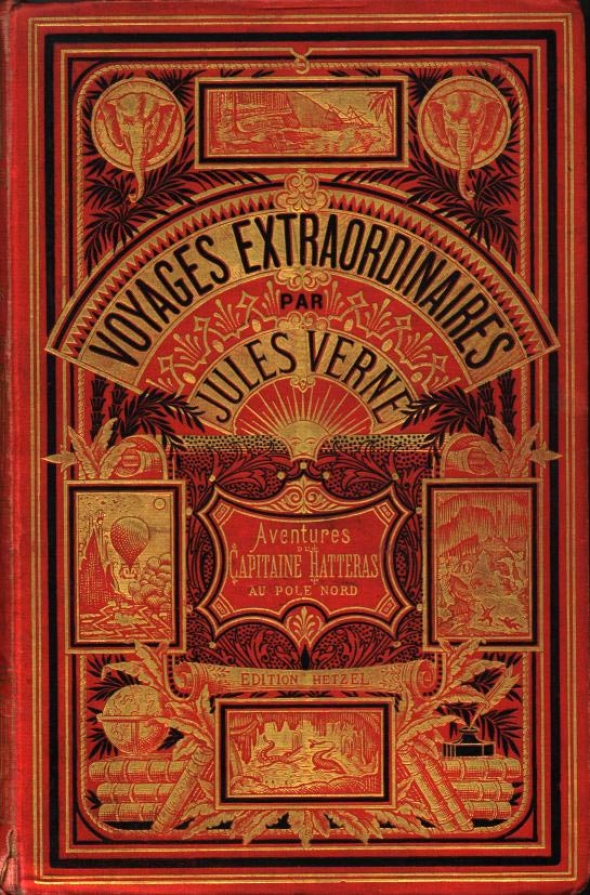
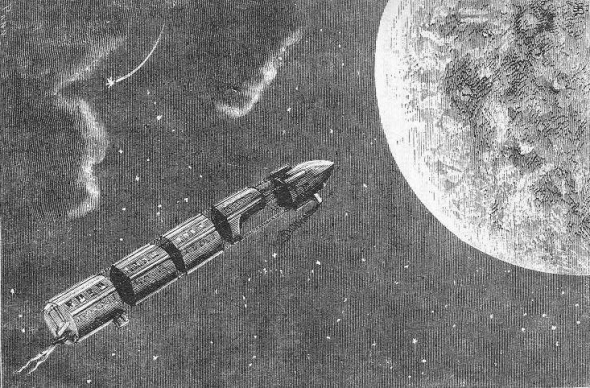
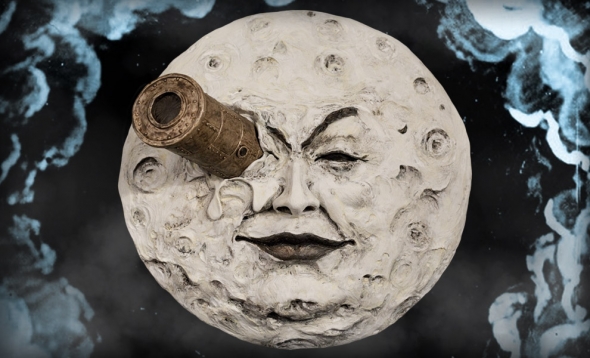
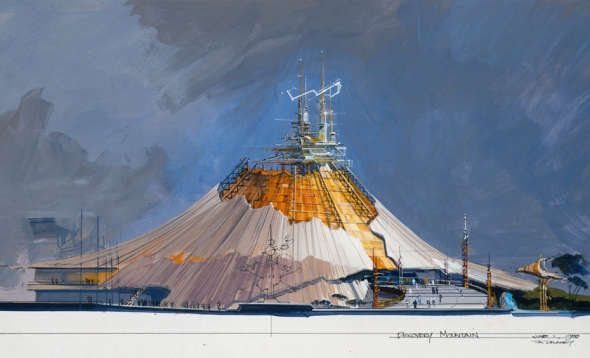
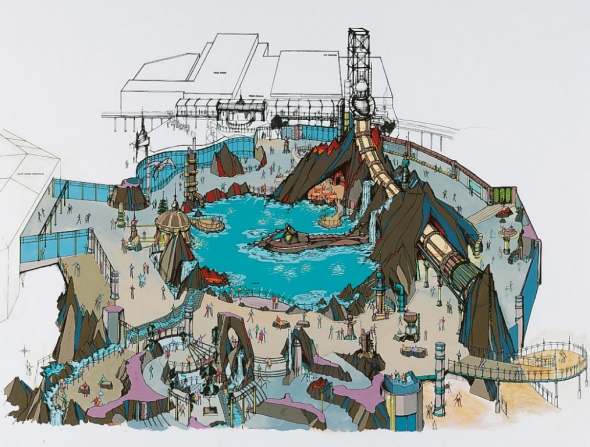
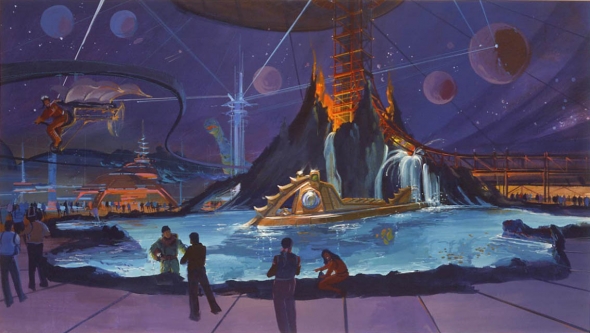
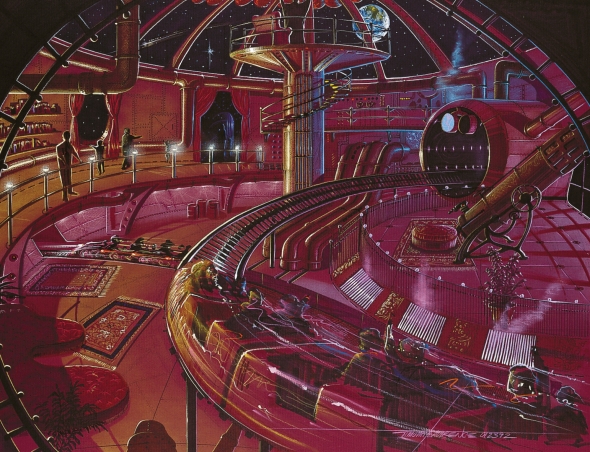
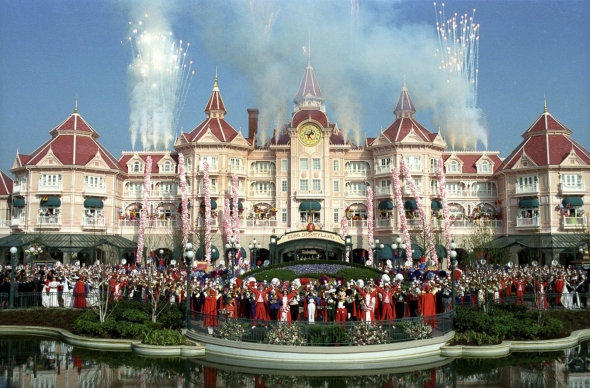
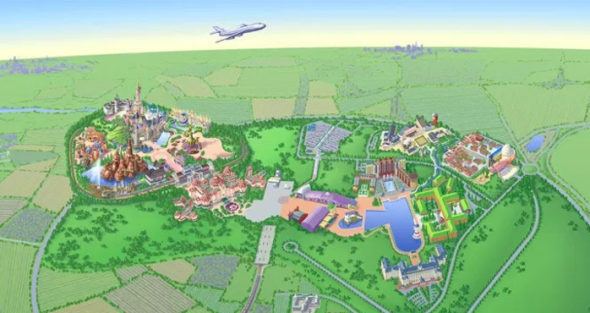
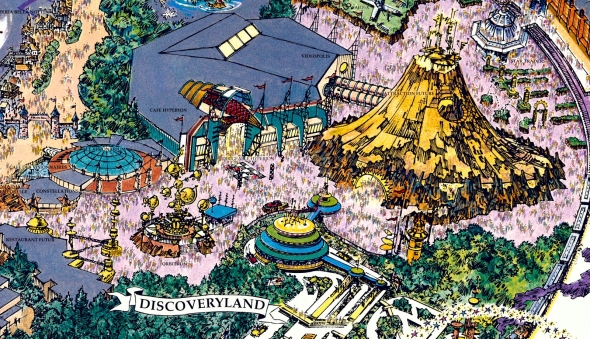

Comments
Excellent article! I was among those who had hoped for a return to the original theming and was utterly disappointed when Hyperspace Mountain was announced. I consider myself lucky that I managed to ride Space Mountain in all its grandeur back in 1998 and I will keep hoping that someday De la Terre à la Lune will make a glorious comeback!
Great post! Even though I rode SM million times and already knew a lot I could learn some new stuff here. :)
I have a little golden nugget for you that either you did not know or were not mentioning intentionally. But anyway, there's a really great 3D modelled reincarnation of Space Mountain (or Discovery Mountain as even the then built ride should have been named, as far as I know?!): https://youtu.be/ttgSaGR5s90 Also check out his website http://www.noacco.net/immersarium/ where you can get a live 3D version of Space/Discovery Mountain where you can even move. I just love it. :)
The same guy did also 3D model Star Tours, check out his channel.
Thanks,
Max
This guy is so frustrating. He writes great in-depth articles and then completely ruins it by shoehorning his tired opinion that everything new is awful at the end. This quote for example.....
"It’s the most recent in what’s become Disney’s new calling card: hastily and thoughtlessly stuffing hot intellectual properties into the parks, even at the expense of cannibalizing classics and decimating themed lands."
Wah wah wah
I rode both De La Terre a la Lune and Mission 2 countless times, and I can tell you without a shadow of a doubt that Mission 2 blows De la terre out of the water on every level. Hyperspace Mountain will no doubt be incredible, by this guy wants to dump all over it before it has even begun because in his mind everything should stay the same as it always was - nothing should ever change or evolve. How boring.
It's annoying because he's clearly a good writer and his articles are informative and entertaining, but he feels he HAS to drive in his bored, polarising opinion at the end.
While I think you're right about the articles being too negative about anything new, saying that Mission 2 was better or even close to as good and consistent as De La Terre a la Lune is something I can not follow at all.
As the article states, it still was one of the best themed coasters ever, but it was completely lacking the soul and uniqueness of the original while also forming an odd contrast to it's exterior and the whole of discoveryland. I still hope it will return some day as the new trains still have that look to them. For me, the original Space Mountain Paris will always be the greatest roller coaster overall experience ever.
It's often inspiring and heartbreaking to see what has "could've been." I've often daydreamed of an additional to Animal Kingdom (perhaps replacing Rafiki's Planet Watch) that would adapt the Thunder Mesa concept as a trip to the arctic. Rather than a giant mesa to explore we are brought to a glacier face, inside could be a Journey to the Center of the Earth inspired ride!
Or how about a reimagined Edison Square edition just off Main Street where we have a Mystic Manor style visit to Menlo Park?!